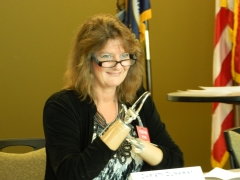May 9, 2012
The Southeast ADA Center, one of 10 regional centers across the country providing information, training and technical assistance to promote voluntary compliance with the Americans with Disabilities Act (ADA), participated in a panel discussion May 8 in Atlanta with the national Social Security Advisory Board.
The Southeast ADA Center, a project of the Burton Blatt Institute at Syracuse University, was honored to be one of the Atlanta-area resources for persons with disabilities selected to take part in the fact-finding presentation and discussion with the Social Security Advisory Board. The Advisory Board is an independent, bipartisan entity created by Congress and appointed by the President and Congress to advise the President, the Congress and the Commissioner of Social Security on matters related to Social Security and Supplemental Security Income (SSI) programs.

Christy Dunaway, Chair of the Southeast ADA Center’s Affiliate Council and Director of Living Independence For Everyone (LIFE) of Mississippi, a center for independent living, represented the Southeast ADA Center, a regional center headquartered in Atlanta with an eight-state network of affiliates that includes centers for independent living, employers and businesses, nonprofit organizations, and state and local government agencies. The Southeast ADA Center as well as the ADA National Network is funded by a grant from the National Institute on Disability and Rehabilitation Research (NIDRR) of the U.S. Department of Education.
Dunaway delivered an opening statement and joined in a question and answer session as the board sought feedback on whether or not Social Security Disability programs are serving persons with disabilities effectively and, if not, what improvements could be made to enhance service.
“I am wearing three hats today: I represent the Southeast ADA Center; I am a person with a disability; and I am an employer,” Dunaway shared. “One fundamental core value and belief underlies our comments today: All people of working age with disabilities can work if they have access to appropriate education, training, and vital supports such as technology assistance, transportation, and personal assistance services.”
Dunaway stated that “the current disability insurance program has yet to find the right mix of incentives, rewards, alignment, and coordination with other disability support programs and systems that will allow people with disabilities to work and meet their essential health and living needs.”
She cited complex rules, fear of losing healthcare benefits and the inability to maintain even modest savings or assets in order qualify for benefits as key obstacles keeping 1 in 3 Americans with disabilities living in poverty, double the national poverty rate and among the highest of any underserved population in America.
“More SSI and/or SSDI (Social Security Disability Insurance) beneficiaries want to work, earn more and move out of total dependence on government benefits. And they would: if incentives were easier to understand and use; if SSI asset limits were modified; and if SSDI modified the current cash cliff dilemma and allowed a gradual reduction of benefit as more income is earned,” Dunaway said.
Speaking from personal experience as both a person with a disability and an employer of individuals with disabilities, Dunaway said healthcare costs are a major issue, and can account for a majority of a person’s salary. “Any one of my staff will tell you – ‘it’s not about the check, it’s about the healthcare,’” Dunaway revealed. “I can pay them more than SSA can in most cases, but I cannot pay them enough to purchase the medical supplies that private health insurance will not cover, and to also pay for personal assistance if needed.”
“My husband and I spent on average, $7,000 per year for him to have assistance at home. And he only needed a few hours every few days,” she added. “Some individuals may need four or five hours of assistance per day. . . [and] could cost them upwards of $10,000 – $12,000 out of pocket per year. If they make $30,000, they have to spend 1/3 of their salary on healthcare, instead of a mortgage, savings or other steps to achieve economic self- sufficiency.”
On behalf of the Southeast ADA Center, Dunaway also urged the Social Security Administration and other agencies to move beyond a focus on employment as an ‘end goal’ and to look at employment as a means to advance on a path to economic self-sufficiency.
To help persons with disabilities advance their fiscal independence, Dunaway shared the Southeast ADA Center’s recommendations which included raising asset limits for federal programs such as SSI and Medicaid to allow recipients to build a modest pool of savings to take steps out of poverty, indexing asset limits to inflation, increasing the level of earnings for SSI recipients to remain eligible for Medicaid waivers, and requiring all SSI recipients to develop a PASS plan that includes asset building as well as employment goals.
“Disability, whether from birth, genetics, or acquired through accident, illness or service to our country, should neither determine an individual’s economic success nor affect a person’s ability to live their American dream,” Dunaway shared in a written statement. “The pursuit of the American dream is an opportunity that should be made available to all Americans, and changes to the current Social Security system for persons with disabilities will help achieve that goal.”